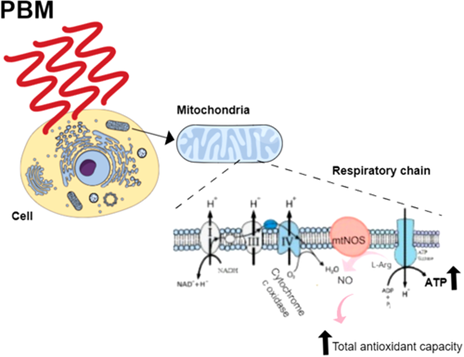Not known Details About Photobiomodulation
Wiki Article
Some Known Questions About Photobiomodulation.
Table of ContentsPhotobiomodulation for BeginnersNot known Incorrect Statements About Photobiomodulation A Biased View of PhotobiomodulationThe 7-Second Trick For Photobiomodulation
Laser therapy is a clinical treatment that utilizes concentrated light to stimulate a procedure called. During PBM, photons go into the cells and engage with the cytochrome c complex within mitochondria. This communication sets off an organic cascade of occasions that brings about a rise in cellular metabolic rate, which can as well as accelerate the healing process.There is agreement that the application of a restorative dose of light to damaged or useless tissue results in a cellular action mediated by mitochondrial mechanisms. Photobiomodulation. Research studies have actually revealed that these adjustments can influence discomfort and swelling, as well as, cells repair service
Modifications in ATP, reactive oxygen species and nitric oxide comply with light absorption by Cc, O. These results are redox state and dose reliant.

Get This Report on Photobiomodulation
PBM tools have actually been removed for advertising by FDA through the Premarket Notification/510( k) process as adjunctive devices for the short-term relief of discomfort. These clearances were based on the presentation of medical information to sustain such claims (Photobiomodulation). In this treatment, a light is positioned near or in contact with the skin, allowing the light power (photons) to penetrate tissue where it connects with chromophores found in cells resulting in photophysical and photochemical adjustments that bring about changes at the molecular, cellular and cells levels of the bodyRemarkably, current research study indicates that light can boost performance in regular cells and cells. The potential applications of PBMT are many and are being checked out experimentally at the basic scientific research, pre-clinical and scientific level. The present medical uses are for the alleviation of discomfort and inflammation and the therapy of sporting activities injuries.

The treatment parameters and number of sessions needed for PBMT are dependent upon area and reason. PBMT usually requires more than one treatment for optimum discomfort alleviation. It might take a number of therapies for the outcomes to come to be noticeable. records that it can take anywhere from 8 to 30 sessions for a therapy to be fully effective, and some patients find it necessary see post to undergo treatment two to four times per week.
The Facts About Photobiomodulation Revealed
Treatment criteria for PBMT were originally developed utilizing cells in vitro and in tiny animal designs. These therapy specifications generally had a reduced irradiance and fluence and worked well for cutaneous applications. When clinicians began to make use of PBMT to deal with frameworks that were located deeper in the body, they utilized these parameters with adverse outcomes.
We now recognize that these negative researches were due to inaccurate gadget and therapy parameters for transcutaneous therapy of much deeper frameworks. Recent developments in laser treatment gadgets and even more study into the suitable dosages have actually drastically boosted the outcomes of PBMT. For dealing with deep tissues, the wavelength of light utilized establishes the deepness of infiltration right into a cells.
It is important that a medical professional makes use of the appropriate wavelength of light and criteria to treat a problem. One wavelength and one collection of treatment parameters will certainly not be efficient for all problems. Adverse side impacts have not been reported from the usage of PBMT.
Photobiomodulation - An Overview
In the initial experiment, Dr. Endre Mester, made use of shaved rats and observing exactly how the laser affected their capability to grow hair compared to the group that was not obtaining LLLT. He found that the team of mice receiving LLLT had the ability to expand their hair back quicker than the team of mice that really did not receive LLLT (Hoon C, et al; 2012).This treatment is described in this manner to differentiate the difference in between the lasers some careers use to cut (eg. in you could try here surgical procedures, or dental procedures). Low-level light treatment is pain-free, non-invasive therapy. It is used to reduce swelling, swelling, and persistent joint disorders, decrease pain and speed up injury recovery of nerves and cells (Hoon C, et al; 2012).
LLLT has a biphasic response, implying that lower doses are typically attended be extra useful than higher doses. That being claimed, doses higher or less than the optimal dose does not affect (Hoon C, et alia; 2012). Therefore, it can be hard to have research studies on LLLT with many parameters.
Some companies combined the go to the website two (LED and laser) to offer a much more all-round therapy considering that lasers can permeate deeper than LED and infrared light (Norman Doidge, The Brain's Way of Healing, 2015). During therapy, the location that is being dealt with is subjected to LED light from a Bio, Flex Laser, which is at 660 nm wavelength, followed by infrared light at 830-840 nm wavelength.
Report this wiki page